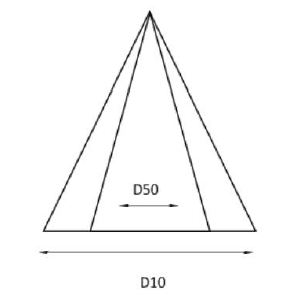Definition of Lux
The amount of light that is cast on a surface is called illuminance, which is measured in lux. This can be thought of as light intensity within a specific area. The higher the Lux, the greater the light intensity.
Light Field Diameter/Pattern
A light field diameter of D10 is the diameter of light field around the light centre, where the illumination is 10 percent Ec. A light diameter of D50 should not exceed 50% of a D10 diameter. The illustration below represents this functionality. The smaller arrow is D50 while the larger arrow is D10. This simply means that 50 percent of the entire pie of light intensity should fall within 50 % of its total diameter.

Colour Temperature & Kelvin Rating
Colour Temperature is a scale that measures and describes how ‘warm’ (yellow) or ‘cool’ (blue) the light from a light source is. Colour Temperature is often categorised as Warm White, Cool White or Daylight and is measured in degrees of Kelvin (K) on a scale of 1,000 to 10,000.

Values in Kelvin
The low end of the Kelvin (K) spectrum is red, and the high end of the spectrum is blue. Right in the middle is daylight. Essentially the lower the number the ‘warmer’ or yellower the light whereas the higher the number the ‘cooler’ or bluer the light. The whiteness of a light is particularly important to distinguish different colours in flesh and body fluids required for accurate examination. Warm & Cool Colour Temperatures, having more yellow, red, blue and green tones, can therefore alter how we see colour and inhibit accurate diagnosis. Medical lighting therefore typically uses a Kelvin range of 5,000 K to 6,500 K with the light becoming whiter, the higher the number towards 6,500 K. It is important to note however that continuing beyond 6,500 K the appearance of the light becomes an ‘Overcast Daylight’ with the introduction of blue light.
Colour Rendition (85 – 100) is the measure of quality of light and it is often referred to as the colour rendering index (CRI). Natural colours of objects are best visualized under the bright daylight, to which lighting devices are compared (reference value of 100). Lights with “good” colour rendition have a CRI over 80. Lights with very good colour rendition have a CRI over 90.
Depth of Illumination
The light’s ability to minimize the effect of obstructions. The depth of illumination without needing to refocus is the sum of the two distances L1 and L2. This threshold value is measured at 60%.
All Information is freely available online
Surgical & Exam Lighting Comparison Table
BATTERIES & BULBS
AIR STERILIZER
SMALL ANIMAL
Millpledge Catheters
Tom Tiddle – Kitty Kath
– Jimmy Riddle
Millpledge Wrapz – Bandages
Chewy NoNo
Funny Farm
Millpledge Ease-Off
Bandage Remover
Millpledge Dermafuse Tissue Adhesive
Spey Hooks / Aural Forceps
Monitoring





